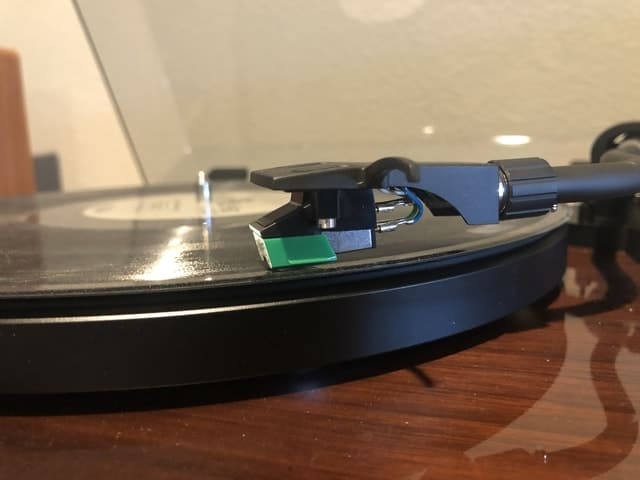We love our records and the quality of music they produce. However, sometimes, they start to skip, affecting the quality of music and ruining the mood. We might need to understand the possible cause before trying to fix it.
Records skip due to dust, unbalanced tonearm, or damage. You can often fix the skipping by cleaning the dust, removing the grime, balancing the tonearm, or trying to fix the damaged record.
Skipping records could kill the mood of your listening session. With many possible causes of your record skipping, identifying the probable cause is the first step to fixing this problem.
You might want to stick around because we’ll share the likely causes of your skipping record, possible solutions, and ways to prevent your record from skipping in the rest of the article.
Dust and Dirt
How long have you had your records stored away? The paper cases aren’t dustproof. Naturally, over time, dust comes to settle in the grooves on your record.
Improper record storage could also cause dirt to lodge into the grooves on your record, thus interrupting your music play. Other contaminants like oil from your hands can transfer onto your records, thus causing them to skip (source).
Damaged Record
We hate to be the bearer of bad news, but your records might be damaged. You might want to look over it carefully. Scratches or damage in the vinyl might be responsible for your record skipping.
Again, not storing your records properly could be responsible for your records getting scratched.
Do you see the dust and dirt in the grooves of your records? They might also cause damage to your vinyl records (source). Other storage mishaps like stacking your vinyl records during storage could damage them.
Everyday actions like placing your records on a desk is a pretty standard way to get scratches on your records. Your records could also get damaged each time you take them out or put them into their cardboard cases.
Unbalanced Tonearm
Sometimes, the problem lies with your record player and not your record. If the tonearm weight is too light, it might cause the needle to skip grooves on the record player. These jumps give you the familiar record skips.
It gets worse; if your record player continuously skips across your record, it could eventually damage it.
Another issue with your record player that might translate to your record skipping is a heavier tonearm. This weight pushes the pin into the record’s grooves, which might alter how your music sounds and, of course, damage your record.
How to Fix Your Skipping Records
Each possible cause for a skipping record outlined in the above section has different solutions. After you’ve identified a likely cause, you might want to try out these solutions. Consider starting with the more straightforward solutions and work your way up.
Clean the Dust and Dirt
Cleaning off dust and dirt in your records should be the first step in fixing your skipping record. Even if your record looks clean to you, there might be a minuscule dirt layer interfering with your music.
Cleaning With Wood Glue
This is one of the craziest ideas I’ve seen (it’s all over Pinterest and in group boards). Apparently, tou can use wood glue to remove dirt on your records. Here’s how to do it:
- Remove the tonearm from your record.
- Bring the wood glue to your record and place the nozzle to the edge of the inner label.
- Spin your records.
- While your record is spinning, squeeze the glue onto the record while moving outwards to the outer edge.
- Use cardboard paper to spread out the glue evenly on your record.
- Stop spinning your record and leave it to dry for 24 hours.
- Carefully peel off the bone dry glue layer.
- Wipe down your record with a lint-free cloth.
- All dirt should be gone; try playing your record.
If your record plays well after the glue treatment, then dirt was probably the culprit. If this cleaning method doesn’t work out, you can try the others, too.
Cleaning With Cleaning Solution
Cleaning your records with a record cleaning solution is pretty straightforward and shouldn’t take much of your time. Here’s how to do it:
- Read the cleaning solution label and follow it.
- Apply the solution to your record.
- Leave the solution on for a few minutes.
- Rinse the solution with distilled water, careful not to wet the label.
- Dry your record with a lint-free cloth.
- Play your record once it’s dry.
Consider trying the last cleaning method if your record still skips after cleaning.
Spotting Individual Grime
It’s time to whip out your magnifying glass and spot individual grime. This examination might take a while, but it’s essential to be thorough.
You can use a record brush to dislodge grime or dirt you find stuck to your record. You could also use a toothpick to remove tough dirt carefully.
If, after trying out all three cleaning techniques, your record still skips, dirt might not be the issue, and it might be time to explore other options.
Balance the Tonearm
If you notice that the fault comes from your record player, you could try to balance the tonearm. You might need to study your record player’s manufacturer’s instructions before attempting to balance it.
This generic guide will help you balance your record player if you don’t have specific instructions. However, follow your manufacturer’s instructions if there are discrepancies.
Here’s how to balance your record player’s tonearm:
- Set the anti-skate control to zero.
- Unhook and set the yoke.
- Move the rear counterweight to level the arm.
- Set the arm tracking weight dial to zero.
- Adjust the counterweight to balance the arm.
- Return the arm to position and set the yoke.
- Reset anti-skating control to the same weight as tracking weight.
Fix the Damaged Records
If your record is badly damaged or scratched, unfortunately, there’s not much you can do. If your record has warped due to temperature changes, you could try restoring its original shape by applying heat.
On the other hand, deep scratches on your record might not be fixable. There are a few remedies to scratched or damaged records that you could try, although there are no guarantees. If your record is genuinely damaged, you could try these out:
- Sand the record.
- Create new grooves by applying pressure to the needle.
- Use Sugarcube™.
Consider checking out this YouTube video from JaKeAFC09:
How to Prevent Skipping Records
If you’ve already lost one record due to skipping, you could still try to save the others. Preventing your records from skipping might involve proper storage techniques and regular cleaning. Most of these tips focus on preventing scratches or damage to your record.
Here are a few things you could try to keep your records from getting damaged or skipping:
- Balance the tonearm each time you change the cartridge.
- Balance the tonearm routinely.
- Clean your record routinely with a record brush to prevent dirt build-up.
- Always store your records on their album jackets.
- Don’t stack your records; always store them upright.
- Don’t touch your record’s surface to reduce dirt or oil transfer.
Final Thoughts
Records that are skipping are usually the result of damage to the record, and you can prevent it by correctly storing and caring for your records. The article shares possible causes of your skipping records and solutions you can try out. The reasons for record skipping are:
- Dirt on your records
- Scratched or damaged records
- Unbalanced record player tonearm

